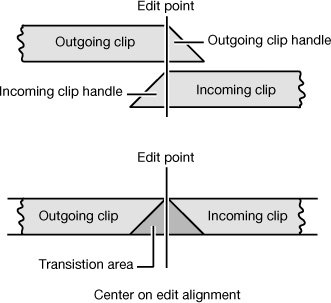Understanding Transitions
| A transition is an effect that is applied to the edit point between two clips. When no transition effect is applied to the edit point, one clip will simply cut to the next clip. In all of the previous lessons, you have been cutting from one clip to the next in every sequence. And when you look at a film or television show, you see that cuts represent the majority of editing transitions. But you can apply a transition effect to an edit point to show time passing, cover a jump cut, change scenes, introduce a new topic, or create video art. One type of transition used frequently in video editing is a video dissolve. A video dissolve gradually mixes the end of one clip with the beginning of the next clip. As the outgoing clip fades out, the incoming clip fades in. In audio, this same process is called a cross fade. The end of the outgoing audio clip fades out while the beginning of the incoming one fades in. This is where capturing additional clip handles becomes important. In order for the fade or dissolve to occur, there has to be enough material past the outgoing clip's Out point to continue and gradually fade out. Likewise, there has to be enough material before the incoming clip's In point to fade in gradually.
|
EAN: 2147483647
Pages: 174
